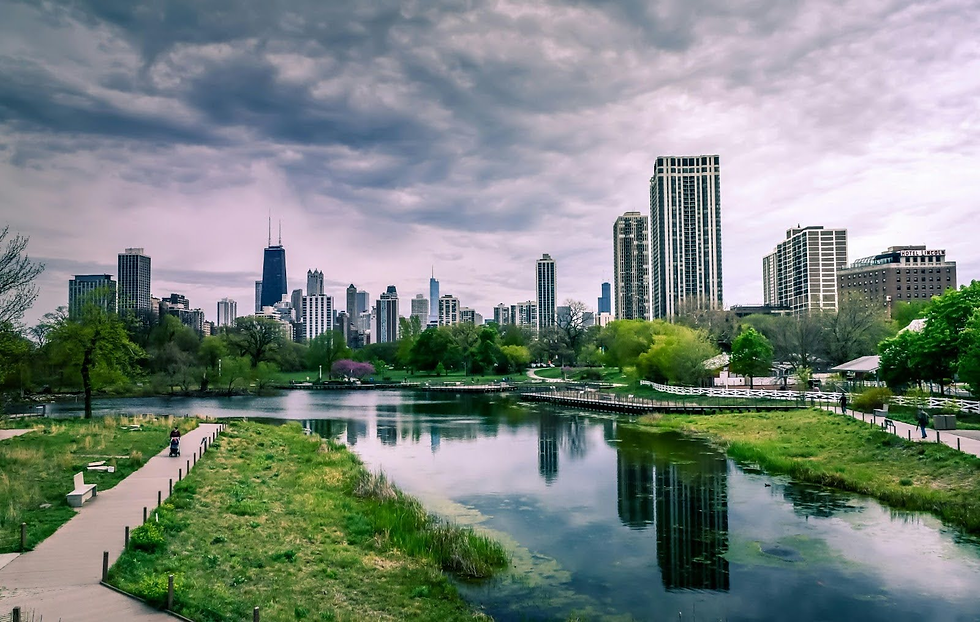Green Infrastructure
- Seaside Sustainability

- Apr 15, 2024
- 2 min read
Kyleigh Adams
The common image of a futuristic city is full of sleek monochromatic metal buildings and bleak concrete infrastructure illuminated by harsh fluorescent lights. In order for humanity to have a livable future this image needs to change. To create a sustainable future the infrastructure should work with nature instead of against it. To combat rising city temperatures and water pollution, green infrastructure is a viable solution to sustain us now and in our future. The EPA simply explains that the function of green infrastructure filters and absorbs stormwater. Back in 2019, when the Water Infrastructure Improvement Act was passed a list of green infrastructure practices were provided. Which includes plant and soil systems, permeable pavement, and landscaping to store, and infiltrate or evapotranspirate stormwater. Stormwater pollution is a serious issue that is worsening because of climate change and its long lasting effects, which includes damaging water quality, sewage overflow, and flooding. Not only does it affect physical structures but also heavily impacts the health of the people in those urban areas.
The Natural Resources Defense Council provides a helpful list of types of green infrastructure that could be implemented into metropolitan areas. A common one that is often overlooked is green roofs. Simply put, green roofs are roofs with landscaped vegetation. Not only are they aesthetically pleasing, but there are many positive attributes these roofs have that help urban areas. Green roofs provide extra insulation and can be up to 40 degrees Fahrenheit cooler than regular dark roofs, and can even decrease city temperatures as much as five degrees. Not only is this great for city temperature and air quality, but it is cost-effective by lowering energy costs. Since these roofs are covered in plants, they are also helpful with sequestering rain and carbon pollution. Green roofs can retain 40% to 80% of total rainfall, helping to keep the plants alive and slowing down runoff. This also slows down or altogether prevents flooding and erosion within the city. Implementing green roofs into urban infrastructure will help with temperature control, rainfall pollution, carbon pollution, decrease energy usage, and create new jobs.
A program created by the Nicholas Institute at Duke University known as the “Infrastructure Sustainability Learning Initiative” or ISLe, is a network meant to help government officials, engineers, developers, and financiers connect and learn about sustainable infrastructure. By connecting sustainability experts with urban planners, construction contractors and city government officials’ new knowledge is shared and implemented into how a city is built and functions. The most important part of sustainability is the connection of all aspects of life and how a society functions. Implementing change in one sector is a great start, but to make it work in the long run it needs to be applicable to society as a whole. Green infrastructure is a great way to showcase this idea since not only do we need to conserve our remaining natural habitats, but we also need to adapt the way our urban areas function to make real change.
Citations
1. US EPA. (2018, July 3). What is Green Infrastructure? US EPA. Retrieved March 16, 2024, from https://www.epa.gov/green-infrastructure/what-green-infrastructure.
2. Green Infrastructure: How to Manage Water in a Sustainable Way. (2022, July 25). NRDC. Retrieved March 16, 2024, from https://www.nrdc.org/stories/green-infrastructure-how-manage-water-sustainable-way#benefits.
3. Infrastructure Sustainability Learning (ISLe) Initiative. (n.d.). Duke Nicholas Institute for Energy, Environment, & Sustainability. Retrieved March 16, 2024, from https://nicholasinstitute.duke.edu/project/infrastructure-sustainability-learning-isle-initiative.




